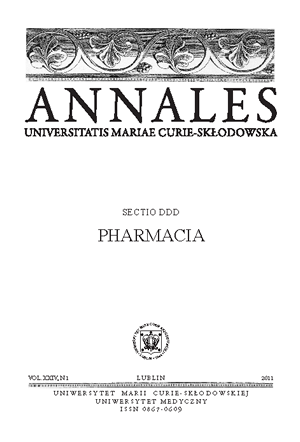The CB1 receptor agonist WIN 55,212-2 fails to evoke physical dependence in Swiss mice
Keywords:
cannabinoids, WIN 55,212-2, rimonabant, dependence, withdrawal, miceAbstract
Potential ability of cannabinoids to produce dependence is still a controversial issue. In our study, in order to examine the cannabinoid physical dependence phenomenon we administered CB1 receptor agonist WIN55,212-2, afterwards, in order to precipitate the withdrawal signs, chronically WIN 55,212-2 treated mice received an injection of rimonabant – an antagonist of CB1 receptors. The present study does not show that administration of rimonabant in mice chronically treated with the WIN 55,212-2 precipitated a signs of withdrawal syndrome.
References
1. Aceto M.D. et al.: Spontaneous and precipitated withdrawal with a synthetic cannabinoid, WIN 55,212-2. Eur. J. Pharmacol., 416, 75, 20011.
2. Aggarwal S.K. et al.: Medicinal use of cannabis in the United States: historical perspectives, current trends, and future directions. J. Opioid Manag., 5(3), 153, 2009.
3. Becker G.L. et al.: Precipitated and conditioned withdrawal in morphine-treated rats. Psychopharmacology, 209, 85, 2010.
4. Biala G., Weglinska B.: Blockade of the expression of mecamylamine-precipitated nicotine withdrawal by calcium channel antagonists. Pharmacol. Res., 51, 483, 2005.
5. Budney A.J., Hughes J.R.: The cannabis withdrawal syndrome. Curr. Opin. Psychiatry., 19, 233, 2006.
6. Castañé A. et al.: Role of different brain structures in the behavioural expression of WIN 55,212-2 withdrawal in mice. Br. J. Pharmacol., 142, 1309, 2004.
7. De Vries T.J., Schoffelmeer A.N.: Cannabinoid CB1 receptors control conditioned drug seeking. Trends Pharmacol. Sci., 26, 420, 2005.
8. González S. et al.: Cannabinoid tolerance and dependence. a review of studies in laboratory animals. Pharmacol. Biochem. Behav., 81, 300, 2005.
9. Griffin G. et al.: Evaluation of cannabinoid receptor agonists and antagonists using the guanosine-5'-O-(3-[35S]thio)-triphosphate binding assay in rat cerebellar membranes. J. Pharmacol. Exp. Ther., 285, 553, 1998.
10. Howlett C. et al.: International Union of Pharmacology. XXVII. Classification of cannabinoid receptors. Pharmacol. Rev., 54, 161, 2002.
11. Jones R.T. et al.: Clinical studies of cannabis tolerance and dependence. Ann. N Y Acad. Sci., 282, 221, 1976.
12. Ledent C. et al.: Unresponsiveness to cannabinoids and reduced addictive effects of opiates in CB1 knockout mice. Science, 283, 401, 1999.
13. Maldonado R., Rodríguez de Fonseca F.: Cannabinoid addiction: behavioral models and neural correlates. J. Neurosci., 22, 3326, 2002.
14. Melis M. et al.: Endocannabinoids mediate presynaptic inhibition of glutamatergic transmission in rat ventral tegmental area dopamine neurons through activation of CB1 receptors. J. Neurosci., 24, 53, 2004.
15. Nocerino E. et al.: Cannabis and cannabinoid receptors. Fitoterapia, 71, 6, 2000.
16. Panagis G. et al.: Behavioral pharmacology of cannabinoids with a focus on preclinical models for studying reinforcing and dependence-producing properties. Curr. Drug Abuse Rev., 1, 350, 2008.
17. Szabo B. et al.: Inhibition of GABAergic neurotransmission in the ventral tegmental area by cannabinoids. Eur. J. Neurosci., 15, 2057, 2002.
Downloads
Published
Issue
Section
License
Copyright (c) 2011 Authors

This work is licensed under a Creative Commons Attribution-NonCommercial-NoDerivatives 3.0 Unported License.


